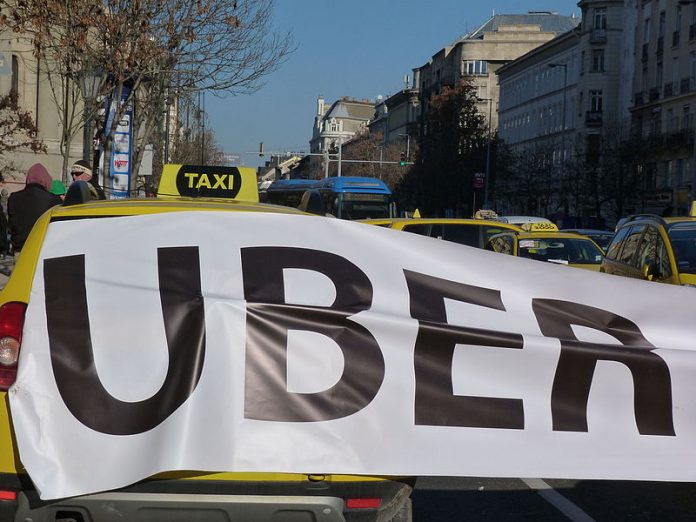Uber has been in the news lately for offering cities a smidgen of their data on traffic patterns. Like so many things with Uber, the company insists what it’s doing is truly and utterly revolutionary. Traffic data management seems to be another scheme in Uber’s overarching plot to worm its way into being an indispensable part of the transportation system while effectively monopolizing the taxi market.
Uber also seems to insinuate it could replace mass transit–although perhaps not rail transit–and do a better job than cities in delivering it, which is ludicrous. Several issues exist with Uber’s whole enterprise and should make cities leery of promoting it and counting on it for their transportation needs.
- Uber is losing massive amounts of money, including a $2.2 billion loss in a nine-month stretch last year.
- Uber seems to be gambling everything on autonomous cars. Specifically, Uber must introduce autonomous cars soon (say within a decade) and ahead of their competitors or their business model may collapse. By rolling out a driverless car network first, a competitor could eat Uber’s lunch.
- Introducing an Uber driverless fleet would cost hundreds of thousands of jobs.
- Uber drivers aren’t going to be thrilled about being replaced by machines, which would likely be a public relations nightmare if and when it does happen.
- Uber is seeking a monopoly on taxi service. Anti-trust laws are a thing, even if conservatives and neoliberals alike have weakened or neglected to enforce them.
- If Uber were to achieve a monopoly, it could easily raise prices. Monopolies are associated with price gouging rather than a healthy capitalist market where competition drives down prices and fuels innovation.
- Uber derives part of its competitive advantage from tax dodging schemes, including insisting it’s a transportation network company, not a plain old taxi company like it is, thus avoiding expensive taxi medallions or insurance. Once cities inevitably re-calibrate the tax code, that advantage will diminish.
- Statistically, Uber service discriminates against African-Americans leading to 35% longer wait times.
- Uber does not lower drunk driving death rates according to the most credible study despite Uber loudly proclaiming itself a drunk driving solution.
- It’s a spiffy app though.
A Monopoly You Say?
In a The Week article titled “How Uber could become a nightmarish monopoly“, Ryan Cooper suggested Uber achieving a taxi monopoly would allow the company to implement far-reaching price discrimination, a form of price gouging furthered by the massive amounts of data it constantly collects on its users.
With traditional cab companies collapsing and most cities reticent to tackle ride-sharing apps head on, Uber would have a chance to dominate the American taxi market to an unprecedented degree. And because any such nationwide taxi monopoly would also have powerful high-tech tools at its disposal, it could be the first company in history to be able to attempt perfect price discrimination — adjusting individual prices so that every taxi customer pays as much as she can afford.
That scenario may sound paranoid but it’s hard to explain investor behavior–namely flushing billions of dollars into a money-losing enterprise–without monopoly-seeking. Cooper explained:
It’s pretty clear Uber is banking on total domination. The company has raked in at least $15 billion in outside investment — including a massive $3.5 billion in a single shot from Saudi Arabia. Some quick arithmetic done by an analyst at Naked Capitalism demonstrates that Uber’s fares only cover about 40 percent of its costs — the rest being subsidized out of investor cash. That, plus the fact that the entire American taxi market has yearly revenues of only $11 billion, suggests one of two things. Either investors are fooling themselves, or they “are assuming this will be a monopoly service,” says Frank Pasquale, law professor at the University of Maryland. The strategy would be to undercut competition with investor-subsidized fares, and then when everyone else is driven out of business, jack prices through the roof and collect monopoly profits. Indeed, the firm claims it already controls over 80 percent of the taxi app market.
Uber’s Fraught Relationship With Unions
Another reason Uber has been in the news in 2017 is the brouhaha erupted over perceived strikebreaking at John F. Kennedy International Airport. New York City taxi drivers staged the work stoppage and protest at JFK in response to President Trump’s Muslim ban, and by opting not to join and in fact turning off surge pricing, Uber was perceived to be breaking the strike. Uber CEO Travis Kalanick had joined an advisory business council to the president, adding to the sense Uber was siding with Trump.
At first, Kalanick tried to push back against the Delete Uber campaign that started in protest: “We’ll partner with anyone in the world as long they’re about making transportation in cities better, creating job opportunities, making it easier to get around, getting pollution out of the air and traffic off the streets,” Salon reported Kalanick told employees. By the way, the anti-pollution collaboration was hard to envision since the new administration has made climate change denial and dismantling the Environmental Protection Agency a central to its platform. Ultimately, after mounting pressure Kalanick ended up quitting Trump’s business council, perhaps to slow the trend of customers deleting Uber from their phones.
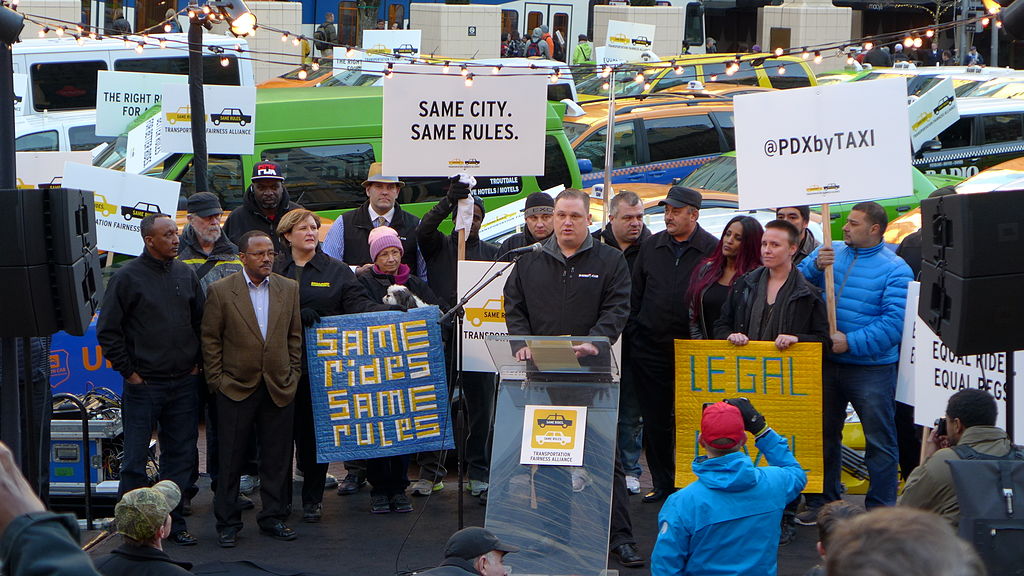
Taking a step back though, Uber’s relationship with unions has been strained for a long time. Kalanick likes to frame Uber as taking on the “Big Taxi Cartel” and it’s clear who’s winning. Uber has helped drive a number of taxi companies to file for bankruptcy, such as San Francisco‘s largest, traditional taxi company last year. The largest taxi company in the world is now Uber; so, it’s hard to see them as the underdog taking on “Big Taxi.” Uber is Big Taxi.
And drivers expecting the Democratic Party to intervene on their behalf in Congress should remember Barack Obama’s campaign manager and former Senior Adviser David Plouffe is closely tied to Uber, working as an executive starting in 2014 and later as a senior strategist. (In January, Plouffe was hired away by Facebook CEO Mark Zuckerberg’s social advocacy outfit, where he also may be helping Zuck plot a presidential run.) Uber likely thought they were buying some lobbying power when they dropped millions of dollars hiring him. Plouffe made a lobbying trip to the Seattle in December 2015 and told Seattle Times reporter Daniel Beekman that Uber drivers didn’t need a union, and, by virtue of being independent contractors, they had no legal right to engage in collective bargaining, anyway.
Seattle’s Uber Driver Union Push
In 2014, Seattle Uber drivers began a push to unionize. Uber management pushed back and questioned their motives. The drivers’ complaints were many, including being suspended with little explanation and an authoritarian attitude and lack of respect from managerial staff. The Uber app interface also makes it difficult and less likely customers will tip their drivers, which ends up further driving down drivers’ income. In December of 2015, the Seattle City Council passed a first-of-its-kind law explicitly allowing Uber and Lyft drivers to unionize. Momentum was still slow and Uber ramped up advertising using scare tactics to paint unionization as bad for drivers, including a Superbowl ad. Uber followed that up with a lawsuit against the City of Seattle last month. It’s hard for local unions to match the resources of a global behemoth, but perhaps Seattle Uber drivers will succeed in their unionization efforts.
Wage Wars
For many drivers, it doesn’t seem Uber pays particularly well, perhaps less than minimum wage in some cases–although granted that’s legal since Uber classifies its drivers as independent contractors. Uber slashing fares last year cut into driver wages and the “guaranteed hourly” program it implemented (for qualifying full time drivers in some markets) to compensate didn’t prove very beneficial and actually ate into the boost drivers formerly got from surge pricing. And of course, after factoring in expenses like gas and vehicle depreciation, some drivers report barely turning a profit (see video below). Some Uber drivers even sleep in their cars to clock more hours or avoid long commutes to neighboring cities where they reside.
ScIQ’s video may overstate the case somewhat by ignoring the per-minute compensation drivers receive during a fare and suggesting drivers need a new car every two to three years when cars may last longer than that. However, it illustrates how driver profits can evaporate under closer scrutiny. People brush off the $0.54 per mile federal mileage depreciation rate at their own peril. Eventually cars break down (or age past Uber’s car year requirements) and for an Uber driver that could mean their livelihood, and they’re on the hook to replace it. Do Uber drivers earn a living wage? Some probably do, but it’s very hard to guarantee with the model Uber has set up.
Drivers also have to deal with the problem of “dead miles,” which is the time between fares. Not only are drivers not paid for this time, they also rack up miles and burn fuel. The arrangement is made more unfair by the fact that Uber continues collecting traffic data on their drivers during these dead miles when they aren’t compensated. This is the data Uber is trying to market to city governments and that it uses to fine tune its algorithm. Not paying drivers for dead miles is harder to justify in that light.
Uber As Supplemental Income
About half of Uber driving is done by part-time drivers. “The company proudly proclaims that the share of drivers who work less than 10 hours a week has climbed to more than 60 percent,” Bloomberg News reported. “What Uber has never said publicly is that half of the driving gets done by people who work more than 35 hours a week. Those workers generate about half of Uber’s revenue and are responsible for about half of Uber’s trips.”
Full-time drivers are the backbone of Uber’s business, but Uber has enough part-timers to deal with surges in demand, and, to take the cynical line, prevent full-time drivers from gaining too much power in labor negotiations. As an added bonus, the spare-time drivers make for a good promotional ad and distract from the sense that Uber is exploiting its full-time drivers by not classifying them as employees and thereby providing them employee benefits. Providing a supplemental income to people who are struggling to make ends meets is a worthy goal but unfortunately Uber helps create the problem it supposedly alleviates by skirting labor laws with the independent contractor designation and driving down wages with its various schemes.
Uber May Not Lower Drunk Driving Rates
What happened this New Year’s Eve provides a Seattle example of succumbing to Uber hype rather than making sound transportation decisions. The Seattle Department of Transportation (SDOT), in its infinite wisdom, chose to partner with Uber rather than extend transit service past 2am bar close on New Year’s Eve. The partnership consisted of the City offering a voucher worth up to $10 to decrease the cost of an Uber Pool fare (meaning revelers had to share the cab). Now unfortunately shutting down transit service on thousands of New Year’s revelers in various states of inebriation predictably results in massive surge pricing–as much as ten times standard, apparently. Thus, some users still reported paying dearly even with the Uber Pool promotion SDOT negotiated.
Good luck using your $10 @seattledot #VisionZero Uber discount. Here's the price for a 2 mile ride. pic.twitter.com/IuOriJzdJH
— Qagggy! (@Qagggy) January 1, 2017
And keep in mind this Uber partnership was marketed as a way to reduce drunk driving. The City boasted in a press release: “The City of Seattle’s Department of Transportation (SDOT) is teaming up with Uber to prevent alcohol-impaired driving in our community on New Year’s Eve. This long-term partnership is an extension of Seattle’s Vision Zero plan to end traffic fatalities and serious injuries on city streets by 2030.” SDOT did the same for St. Patrick’s Day in 2016. Unfortunately for SDOT’s Vision Zero goal, the most comprehensive academic study to date found no evidence that Uber or Lyft decreased the rate of drunk driving deaths. Apparently, thrifty drunks and surge pricing don’t play well together. We’re really zeroing in on that Vision Zero target, huh?
Displacing Transit Service
Beyond Uber and cities marketing the techified taxi service as a solution for holiday drunk driving, they’ve also argued Uber can solve the last mile problem of transit or take over some of the lowest return transit routes in hard-to-serve areas. Some cities–like Altamonte Springs, Florida–have even offered their residents Uber discounts in place of putting bus lines into low-density neighborhoods. This is a fine strategy insofar as it saves cities money, is sustainable long-term, and does not leave in the lurch citizens without data plans or the means to pay a more expensive cab fare.
Unfortunately, Uber has also fought to displace transit by seeking higher road priority. Uber pressured Pittsburgh, where it’s testing its self-driving technology, to allow its cars access to bus-only lanes. Uber’s condescending attitude eventually soured its relationship with Pittsburgh officials, leading them to call a one-way relationship in which they’ve given Uber carte blanche and gotten nothing in return, as Quartz reported last Tuesday. Filling bus lanes up with taxis is a sure way to worsen transit service, and Uber was wrong to make such demands of cities.
Another city, Columbus, Ohio, won a $50 million federal Smart City grant to pioneer smart self-driving infrastructure on its streets, which was hailed as the future of public transportation and a great boon for carless low-income residents. As if simply replacing drivers and doing some data analytics will make the whole transportation system miraculously better and lift people out of poverty–essentially the Uber argument. Time will tell.
Of course Uber’s actions have hinted at replacing or privatizing transit service. Matt Buchanon detailed Uber’s efforts to replace bus routes like the MUNI 22 in San Francisco with its new “Smart Route” service in his “The Uber Endgame” piece in The Awl. This could be a worrying trend for society, as Buchanon explained:
One of the more subtle underlying issues with the rise of Uber is the company’s slow siphoning of the political will to fix existing — or build new — public transit infrastructure in major cities. In Affluence and Influence: Economic Inequality and Political Power in America, Princeton Professor of Politics Martin Gilens shows that — as he put it in an article with Northwestern Professor of Decision Making Benjamin Page — “economic elites and organized groups representing business interests have substantial independent impacts on U.S. government policy, while mass-based interest groups and average citizens have little or no independent influence.” As the wealthy — and, as the prices of Uber and Lyft fall, the slightly less so — essentially remove themselves from the problems of existing mass transit infrastructure with Uber and other services, the urgency to improve or add to it diminishes. The people left riding public transit become, increasingly, the ones with little or no political weight to demand improvements to the system.
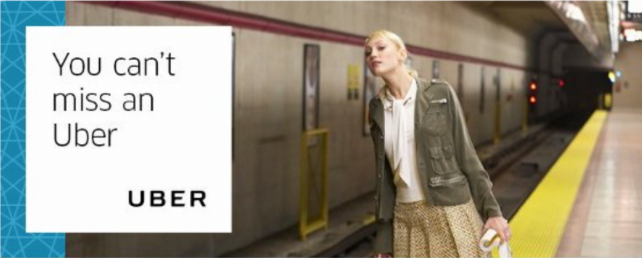
And in the process of privatizing transit service, Uber might have to come for existing transit service more directly. Uber has run ads that suggest, unlike a subway train, “you can’t miss an Uber.” Jarrett Walker criticized the ad and Uber said it took it down, but Walker argued the ad laid bare Uber’s anti-transit strategy. Cities should not welcome or hasten Uber’s attempts to disrupt high capacity transit systems. High capacity transit lines carry loads of people that taxis could never dream of facilitating, even with things like Uber Pool or Smart Routes. If Uber concedes transit must continue to operate in high demand corridors, replacing more middling bus routes would likely still lead to more traffic congestion while potentially putting low-income residents at risk of having no viable transportation option.
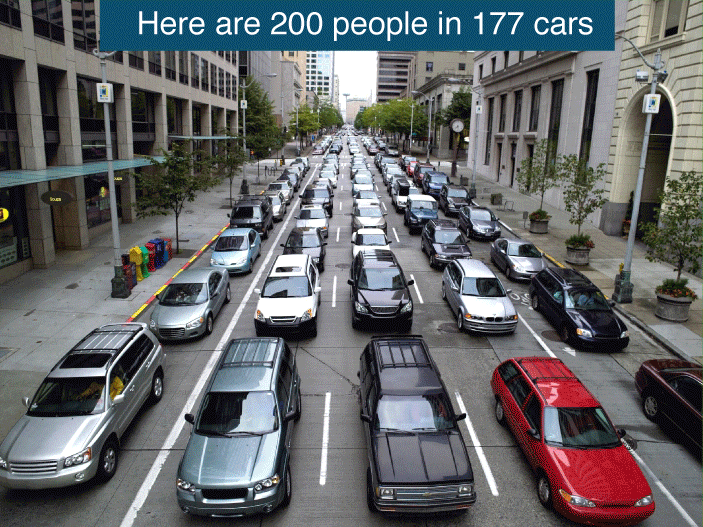
Ryan Cooper echoed the fundamental street geometry problem that Jarrett Walker and other urbanists have tried to hammer home in response to those who think Uber and/or self driving car will fix everything:
Finally, America’s already-lousy public transportation would rot, as the taxi monopolist uses its political influence and market power to force people into using taxis wherever possible. A taxi app could be an excellent complement to public transport, helping people get to and from the bus stop or train station, but a taxi monopolist is certain to view those services as just another competitor to be stamped out. The resulting congestion — as trains and buses are capable of tremendously more throughput than cars — would be abysmal.”
Uber’s Discrimination Problem
The sharing economy is often presented as a panacea for what ails the economy and society writ large. Unfortunately the hard data paints a much less flattering picture. A study found that people with African-American sounding names had to wait 35% longer than whites in Seattle. Additionally, “across all trips, the cancellation rate for African American sounding names was more than twice as frequent compared to white sounding names.” African Americans have reported similar problems with AirBnB, and studies have borne that out. Moreover, the tech industry as a whole has done a poor job of hiring African-Americans and women, and Uber is likely no different since it refuses to disclose diversity data like other tech giants do.
The Allure of Autonomous Vehicles
The allure of autonomous vehicles is undeniable. Driving can be an incredibly tedious endeavor. Having a computer do the humdrum work instead sounds great. More time to noodle around the Internet! Or, do work on the way to work: a corporate manager’s dream in this late capitalist era of widespread suburban sprawl.
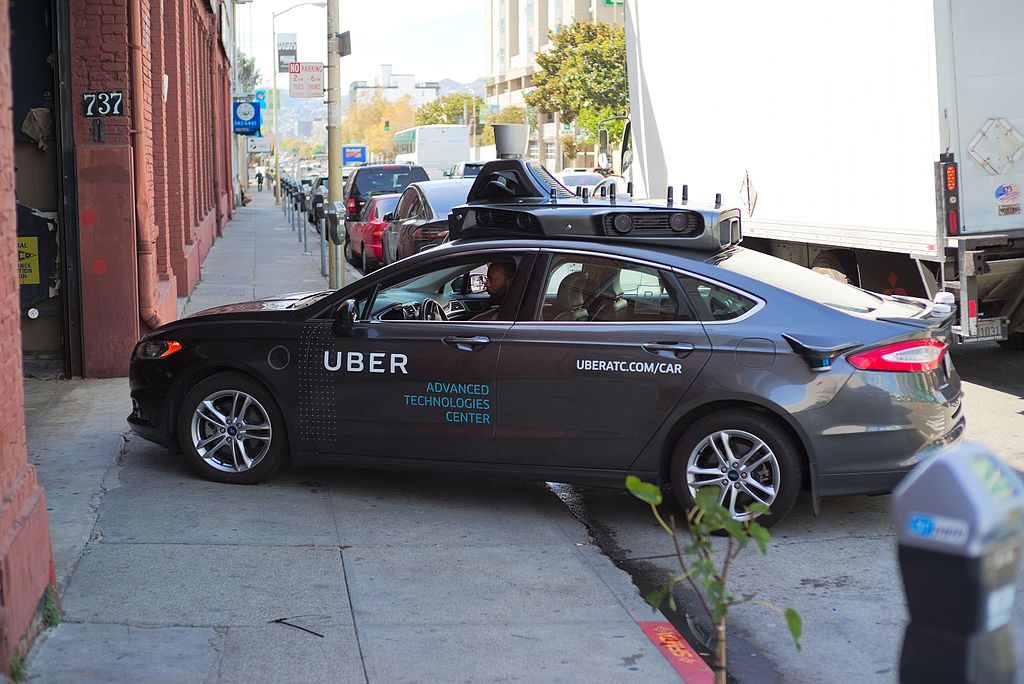
If computers end up being really safe vehicle operators as proponents suggest, autonomous vehicles could also make our streets much safer. Collisions took 37,000 lives in the United States last year and countless more were seriously injured. Another frequently talked about crisis, the opioid epidemic, is linked to traffic violence since many get hooked on painkillers while trying to recover from injuries from collisions. If autonomous cars can make a deep cut in traffic violence, then many would welcome our robot overlords with open arms.
Of course autonomous vehicles would have to prove they are safe–for passengers, bicyclists, and pedestrians alike–before they could gain widespread acceptance and stem the tide of traffic violence. Self-driving prototypes have yet to be perfected, with several collisions and traffic infractions reported. And tragically in June a Tesla with autopilot activated killed a man when it collided with a truck. Tesla didn’t admit fault–the man was supposed to be monitoring his autopiloted vehicle–and argued its traffic fatality rate was still lower than conventional cars since its first death happened after 130 million miles driven, which is 38% more than the US average according to Tesla data: “Among all vehicles in the US, there is a fatality every 94 million miles,” the company noted. Of course Tesla’s safety numbers benefit from some human intervention since its drivers back up the still spotty self-driving technology.
Regardless of the allure of autonomous vehicles, cities must focus on what works and avoid falling into the trap of pursuing something only because its new and hip. Likely, a framework determining how to treat autonomous vehicles for legal reasons will need to be established before fully driverless technology can reach widespread implementation. If an autonomous vehicle were to cause a human traffic death, who would be responsible? The programmer of the technology? The corporation who sold it? Nobody? Unfortunately, we must answer these questions at a time when justice system is under assault from a number of fronts–whether by being supplanted by private arbitration or being undermined by the executive as a coequal branch–and corporate power is on the rise.
The Supreme Court lurch to the Right could doom efforts to pare back the excessive use of binding arbitration, which the New York Times analysis showed favored corporations in a vast majority of cases, including 80% of class actions between 2010 and 2014 and 95% of cases in a sample complied in 2007. The New York Times explained:
Over the last 10 years, thousands of businesses across the country — from big corporations to storefront shops — have used arbitration to create an alternate system of justice. There, rules tend to favor businesses, and judges and juries have been replaced by arbitrators who commonly consider the companies their clients, The Times found.
The change has been swift and virtually unnoticed, even though it has meant that tens of millions of Americans have lost a fundamental right: their day in court.
“This amounts to the whole-scale privatization of the justice system,” said Myriam Gilles, a law professor at the Benjamin N. Cardozo School of Law. “Americans are actively being deprived of their rights.”
If Uber is allowed to keep its binding arbitration clause when it converts to driverless technology, then perhaps those injured and the families of those killed in Uber collisions would have little viable legal recourse to seek recompense. That outcome would start feeling a little bit like a first step toward the robot apocalypse. Maybe I’ve just watched too many dystopian movies. Suffice to say, a new legal framework for autonomous cars seems a necessary step before the Great Automation happens.
When Time-Tested Solutions Beat Disruptive Innovation
Transit works and has worked for centuries. Transit works particularly well when it has sufficient frequency and dedicated lanes that prevent it from getting stuck in traffic, which should be where transportation departments focus their energies. Uber may have a role to play complementing transit. The criticisms expressed here could be way off base. Uber may answer lingering questions about racial and economic equity, workers rights and compensation, and monopoly-seeking. Maybe Uber really does have some master strategy that will allow them to salvage their business model once venture capital dries up without resorting to monopoly. Cities probably shouldn’t bet on it, though.
The featured image was taken by Elekes Andor in Budapest and is used via Wikipedia Commons.
Appendix A: How Do You Lose More Than $2 Billion In A Year?
In a nutshell:
Uber Hires Veteran NASA Engineer to Develop Flying Cars https://t.co/PDPVh4RpqD
— SPUR (@SPUR_Urbanist) February 6, 2017
Doug Trumm is publisher of The Urbanist. An Urbanist writer since 2015, he dreams of pedestrian streets, bus lanes, and a mass-timber building spree to end our housing crisis. He graduated from the Evans School of Public Policy and Governance at the University of Washington in 2019. He lives in Seattle's Fremont neighborhood and loves to explore the city by foot and by bike.

